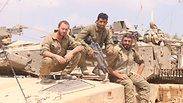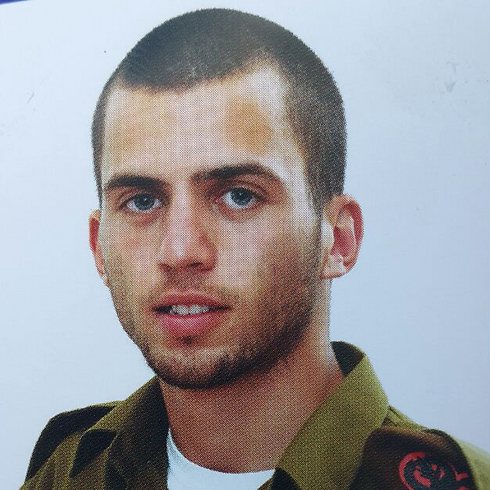
It was one of the hardest nights of Operation Protective Edge – the night between July 19 and 20, the start of the assault on the Hamas stronghold in Saja'iyya, a neighborhood in eastern Gaza City, and the incident that exacted the summer's highest price, when an anti-tank missile slammed into an Israel Defense Forces' armored personnel carrier (APC) and killed seven Golani Brigade soldiers, including Staff Sergeant Oron Shaul, whose remains were snatched by Hamas fighters.
Now, testimonies and statements from junior commanders in the field at the time are pieced together and paint a chilling picture of what happened that terrible night on the outskirts of Saja'iyya.
The fighters said their initial orders were to take control of two high-rise buildings Saja'iyya, but that their objective was amended some two hours before the start of the battle in light of new intelligence reports. And that's how, they said, four Armored Corps tanks, followed by two APCs carrying fighters from Battalion 13 of the Golani Brigade, ended up moving deep into the Gaza Strip.
At some point, the fighters continued, communication between the four tanks was lost and the two tanks at the back lost their way, thus leading the two APCs behind them along the wrong route and into a lemon orchard. Suddenly, the first APC ground to a halt, but the two tanks drove on, leaving the Golani fighters alone.
'My finger on the pin'
First Lieutenant Ohad Rozwold, the commander of the APC that broke down, and his radio operator got out of the vehicle, went over to speak to the commander of the second APC, and then headed back to their own vehicle again.
"I was about a meter and half or two meters from the APC when it exploded," Rozwold later recalled. "They fired an RPG that hit the APC's engine and caused an explosion. I was left lying there without a weapon, with my legs paralyzed and unable to move. I removed a grenade from my battle vest and my finger was on the pin."
G. witnessed the explosion from the second APC. "Suddenly I saw something that looked like a comet flying and hitting the APC," he recounted.
"No one knows exactly where the soldiers were. Ohad said he saw two soldiers outside the APC by then, but the IDF still hasn't been able to investigate and tell the families exactly where the soldiers were killed."
The IDF believes that all the soldiers killed in the incident were in the APC itself when the missile struck.
"Immediately after the missile hit, we came under heavy Kalashnikov fire," G. said. "I could see Ohad's APC on fire and I screamed into the radio: 'I have an APC on fire; the entire crew is dead'. I simply couldn't believe my eyes."
Sergeant Aharon Amar, 23, also witnessed the explosion from the second APC. "It was like a terrible movie going through my head, but I realized we have to press on and get the rest of the guys moving," Amar said. "It's not easy watching your friends burn, but you have to keep the operation going."
G. and the other soldiers from the second APC then began making their way towards the burning vehicle. "Ohad's radio operator saw us approaching and thought it was a terror cell, and his weapon was already aimed at me," G. recalled.
"He asked Ohad for the okay to open fire, but Ohad asked him to describe my silhouette – and at the last minute, just before the radio operator pulled the trigger, he told him it was me and not to shoot. He saved my life; another second and they would have killed me."
'No bodies intact'
At the same time, the troops were coming under fire from all directions.
"I said on the radio that I need the tanks as quickly as possible because I can't move towards the burning APC without cover fire," G. said. "The APC was just 20 meters away from me but everything was on fire and the area was all lit up. I was afraid that if we approached, the force will sustain more fatalities."
G. tried to direct the tank company commander to the location, but the commander was unable to find them due to the navigation error at the start of the operation. According to the fighters in the field, it took the tanks more than 40 minutes to arrive on the scene, despite the fact that they were just 400 meters away.
"I try to direct the tank company commander to me, but it took him time to get here because he didn't take the same route we did," G. noted.
"There's a doctor in the company commander's tank, and Ohad was starting to lose consciousness by then. He got hit by bullets in the legs, broke two vertebrae in his back and there was a piece of shrapnel in his arm. The medic had stopped the bleeding. But the company commander and the doctor weren't showing up."
When the tanks arrived, G. and the other fighters tried to dowse the flames with fire extinguishers.
"We soon realized what was happening there," G. said. "There were no whole bodies, everything was on fire, and our efforts to put out the fire were useless. Three fighters who were with me were simply in shock, couldn't move. Shell shock."
Some of the fighters claim that the IDF's findings, which were presented to the bereaved families in recent days, don't paint a complete picture of what went down that night.
"We were given the cold shoulder by the battalion and brigade commanders," they say in their testimonies. "Quite a few things went wrong in that battle, and it can't all be dropped on us, the junior fighters."

















